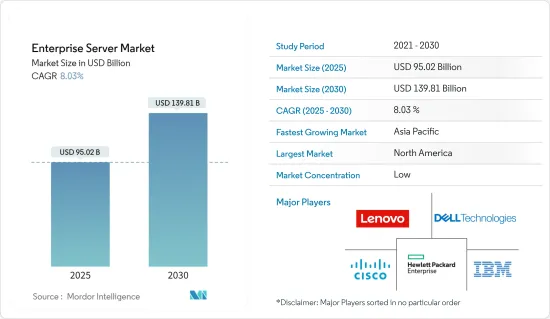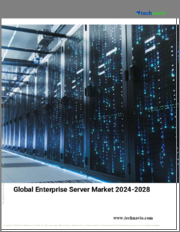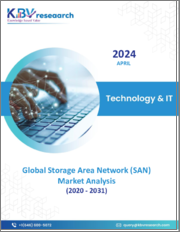
|
시장보고서
상품코드
1640682
기업 서버 시장 : 시장 점유율 분석, 산업 동향 및 통계, 성장 예측(2025-2030년)Enterprise Server - Market Share Analysis, Industry Trends & Statistics, Growth Forecasts (2025 - 2030) |
||||||
기업 서버 시장 규모는 2025년에 950억 2,000만 달러로 추정되고, 2030년에는 1,398억 1,000만 달러에 이를 것으로 예측되며, 예측 기간(2025-2030년)의 CAGR은 8.03%로 전망됩니다.

시장 상황은 빅데이터, 고성능 컴퓨팅, 비즈니스 인텔리전스 용도의 급증을 지원하기 때문에 성능, 속도 및 메모리를 강화하는 강력한 혁신이 확인될 것으로 예상됩니다.
주요 하이라이트
- 기업 서버는 개별 단위, 사용자, 특정 애플리케이션이 아닌 엔터프라이즈 요구 사항을 함께 처리하는 데 필요한 프로그램을 포함하는 컴퓨터 서버입니다. 기업 서버는 연결 통합, 브로드캐스트, TCP/IP, 멀티캐스트 선택, 컨플레이션 및 최대 절전을 위한 사용자 정의 도구를 제공하여 네트워크 및 데스크톱 성능을 향상시킵니다.
- 기업 서버 시장은 하이퍼스케일 데이터센터의 용량에 대한 투자가 증가하고 코어 서버 시장이 재구축되는 것이 주요 요인이 되고 있습니다. 또한 서버 시장은 서버의 업데이트 주기를 확인할 것으로 예상되며 앞으로 수년간 시장 성장에 긍정적인 영향을 미칠 수 있습니다.
- 또한 플래시 스토리지, 가상화 및 고도 관리와 같은 새로운 기술이 시장 성장의 새로운 경로를 제공할 수 있습니다. 기업 및 최종 사용자의 특정 컴퓨팅 요구 사항을 충족하기 위해 개발된 새로운 애플리케이션도 기업 서버 시장 성장에 크게 기여할 것으로 예상됩니다.
- 현재 서버 수는 데이터 트래픽, 워크로드 및 컴퓨팅 관리가 눈사람으로 증가하는 데이터센터 트래픽을 따라잡지 못했습니다. 서버의 컴퓨팅 능력 증가와 가상화, 다중 워크로드 및 물리적 서버당 컴퓨팅 인스턴스 증가로 인해 이 로드를 처리하기 위해 데이터센터를 추가해야 합니다. 이는 세계 데이터센터 인프라에 대한 투자를 촉진하는 주요 요인이 되어 기업 서버 시장의 성장에 크게 기여하고 있습니다.
- 그러나 기업 서버 사용과 관련된 초기 비용과 설치 비용이 높다는 것이 그 확산을 방해하는 주요 우려 사항 중 하나입니다. 하이엔드 기업용 서버는 설치 및 유지보수에 상당한 수준의 기술적 기술이 요구되므로 조사 대상 시장의 장벽이 되고 있습니다.
기업 서버 시장 동향
랙에 최적화된 서버 유형이 고성장
- 랙형 서버는 타워형 서버에 비해 상대적으로 작고 랙에 설치됩니다. 냉각 시스템, 저장 장치, 네트워크 주변 장치, 배터리, SAN 장비 등 다양한 전자 장치를 서버와 겹쳐서 수직으로 배치하도록 설계되었습니다.
- 랙 서버를 사용하는 주요 이점은 사용자가 필요한 전자 장치를 서버와 함께 쌓을 수 있다는 점에서 단일 랙에 여러 서버를 저장할 수 있기 때문에 소비 공간이 적고 전 세계 여러 조직에서 선호됩니다.
- 클라우드 서비스 제공업체의 하이퍼스케일 데이터센터 채택은 예측 기간 동안 시장을 크게 견인할 것으로 예상됩니다. 게다가 랙에 최적화된 서버 수요는 급속히 증가하고 있으며, 산업 각 회사는 이 기술에 대한 투자를 강요하고 있습니다.
- 클라우드, AI/ML, 스토리지, 5G/Edge용 IT 솔루션 제공업체인 Supermicro는 Supermicro 서버의 핵심 포트폴리오에 주요 오픈 하드웨어와 오픈소스 기술 채택을 확대할 것이라고 발표했습니다. 게다가 새롭게 발표된 8U 8-GPU Rack Optimized Systems는 대규모 AI 트레이닝을 위한 뛰어난 전력 및 열 성능을 제공하며 다수의 개방 기술을 탑재하고 있습니다.
아시아태평양이 가장 높은 성장률을 보임
- 아시아태평양은 인공지능, 사물인터넷, 빅데이터 등의 기술이 다양한 최종 사용자 산업에서 채용되고 있으며, 기업용 서버 수요가 증가하고 있기 때문에 가장 높은 성장률을 나타낼 것으로 추정됩니다.
- 또한 아시아태평양에서는 다국적 기업과 국내 기업의 클라우드 서비스 제공업체 지향이 증가함에 따라 데이터센터 서비스가 증가하고 있는 것도 기업 서버의 요구를 뒷받침하고 있습니다.
- 게다가 인도 정부의 클라우드 컴퓨팅 시책은 인도 내에서 생성된 데이터를 인도에 저장할 수 있다고 하고 있으며, 인도 내 데이터 스토리지 센터의 수와 규모가 확대될 수 있기 때문에 기업용 서버 시장이 활성화될 수 있습니다.
- 게다가 Google과 Apple과 같은 대기업은 성장하는 비즈니스를 위해 연결성을 높이고 확장성이 높은 솔루션을 찾고 중국에서 데이터센터를 개설할 계획입니다.
기업 서버 산업 개요
기업 서버 시장은 국내외에도 불구하고 많은 진출 기업들이 진입하고 있기 때문에 경쟁이 심합니다. 현재 일부 진출기업이 시장의 대부분을 차지하고 있기 때문에 시장이 통합되어 있습니다. 주요 기업이 채택한 주요 전략에는 제품 혁신과 M&A가 있습니다. 시장의 주요 기업으로는 Hewlett Packard Enterprise, Dell Technologies Inc., IBM, Cisco Systems Inc. 등이 있습니다.
- 2022년 11월-Lenovo는 ThinkAgile VX 및 ThinkAgile HX와 같은 4세대 AMD EPYC 프로세서가 장착된 ThinkSystem 서버와 ThinkAgile 하이퍼컨버지드(HCI) 솔루션을 발표하여 하이브리드 멀티클라우드를 신속하게 배포하고 인프라 관리를 간소화했습니다.
- 5월 2022일-IBM은 Spectrum Scale Enterprise Storage Server(ESS) 포트폴리오에 더 빠른 컨트롤러 CPU와 더 높은 처리량을 특징으로 하는 ESS 3500을 추가할 것이라고 발표했습니다. 이는 AI 교육을 위해 Nvidia의 DGX 고밀도 컴퓨팅 서버와 함께 작동하도록 설계되었습니다.
기타 혜택
- 엑셀 형식 시장 예측(ME) 시트
- 3개월간의 애널리스트 서포트
목차
제1장 서론
- 조사의 성과 및 전제조건
- 조사 범위
제2장 조사 방법
제3장 주요 요약
제4장 시장 인사이트
- 시장 개요
- 산업의 매력-Porter's Five Forces 분석
- 공급기업의 협상력
- 구매자의 협상력
- 신규 진입업자의 위협
- 대체품의 위협
- 경쟁 기업간 경쟁 관계
- 산업 밸류체인 분석
- 시장에 대한 COVID-19의 영향 평가
제5장 시장 역학
- 시장 성장 촉진요인
- 클라우드로의 전환 증가
- 빅데이터의 성장
- 시장 성장 억제요인
- 서버 가상화의 채용
제6장 시장 세분화
- 운영체제별
- Linux
- Windows
- UNIX
- 기타 OS(i5/OS, z/OS 등)
- 서버 클래스별
- 하이엔드 서버
- 미드레인지 서버
- 볼륨 서버
- 서버 유형별
- 블레이드
- 멀티노드
- 타워형
- 랙 최적화
- 산업별
- IT 및 통신
- BFSI
- 제조업
- 소매
- 의료
- 미디어 엔터테인먼트
- 기타 산업별
- 지역별
- 북미
- 유럽
- 아시아태평양
- 라틴아메리카
- 중동 및 아프리카
제7장 경쟁 구도
- 기업 프로파일
- Hewlett Packard Enterprise Co.
- Dell Technologies Inc.
- IBM Corporation
- Cisco Systems Inc.
- Lenovo Group Ltd
- Oracle Corporation
- NEC corporation
- Unisys Corporation
- Fujitsu Ltd
- Hitachi Ltd
- Toshiba Corporation
제8장 투자 분석
제9장 시장의 미래
AJY 25.02.14The Enterprise Server Market size is estimated at USD 95.02 billion in 2025, and is expected to reach USD 139.81 billion by 2030, at a CAGR of 8.03% during the forecast period (2025-2030).

The market landscape is expected to witness strong innovations to enhance performance, speed, and memory to support the surge of Big Data, high-performance computing, and business intelligence applications.
Key Highlights
- An enterprise server is a computer server that includes programs required to collectively serve the requirements of an enterprise instead of an individual unit, user, or specific application. An enterprise server provides consolidated connections, a choice of broadcast, TCP/IP, or multicast, as well as user-defined tools for conflation and hibernation, resulting in improved network and desktop performance.
- The market for enterprise servers is majorly driven by the increased investments in the capacity of hyperscale data centers to reshape the core server market. The server market is also expected to witness a server-refresh cycle, which may favorably impact market growth over the next few years.
- Furthermore, emerging technologies, such as flash storage, virtualization, and advanced management, may offer new avenues for market growth. New applications (developed to meet specific computing requirements of the enterprises and end users) are also expected to contribute significantly to the growth of the enterprise server market.
- With the current number of servers, managing data traffic, workload, and computing have been unable to keep up with the snowballing growth in data center traffic. With the increasing server computing capacity and virtualization, multiple workloads, and compute instances per physical server, there is a demand for more data centers to handle this load. This has been a significant factor driving investments in data center infrastructure across the world, significantly contributing to the growth of the enterprise server market.
- However, the high initial and installation costs related to using enterprise servers are one of the main concerns preventing their wider adoption. High-end corporate servers demand a significant level of technical skill to install and maintain, which is a barrier for the studied market.
Enterprise Server Market Trends
Rack Optimized Server Type to Witness High Growth
- A rack server is comparatively smaller and mounted within a rack compared to a tower server. It is designed to be positioned vertically, stacking various electronic devices, such as cooling systems, storage units, network peripherals, batteries, and SAN devices, with servers one over the other.
- The primary advantage of using a rack server is that a user can stack any required electronic devices with the server, wherein a single rack can contain multiple servers, hence, consuming lesser space, due to which it is now mostly preferred by many organizations across the world.
- Hyperscale data center adoption by cloud service providers is expected to drive the market considerably over the forecast period. Moreover, the demand for rack-optimized servers is rapidly increasing, compelling the industry players to invest in this technology.
- Supermicro, an IT solution provider for cloud, AI/ML, storage, and 5G/Edge, announced the expanded adoption of key open hardware and open source technologies into the core Supermicro server portfolio. Moreover, the newly launched 8U 8-GPU Rack Optimized Systems delivers superior power and thermal capabilities for large-scale AI Training and includes a host of open technologies.
Asia-Pacific to Witness Highest Growth Rate
- The Asia-Pacific region is estimated to register the highest growth rate, due to the increasing adoption of technologies, such as artificial intelligence, the Internet of Things, and Big Data, in various end-user industries, thus, increasing the demand for enterprise servers in this region.
- The increasing data center services in the Asia-Pacific region, owing to the growing number of multinational and domestic enterprises turning toward cloud service providers, are also driving the need for enterprise servers.
- Moreover, the Indian government's cloud computing policy, which says that the data generated in India may be stored within the country, may ramp up the number and size of data storage centers in India, thus, boosting the enterprise server market.
- Furthermore, major firms, such as Google and Apple, are also planning to open their data centers in China to seek enhanced connectivity and scalable solutions for their growing businesses.
Enterprise Server Industry Overview
The enterprise server market is competitive, owing to the presence of many players in the market in the market, both domestic and international. The market is consolidated as some players currently occupy most of the market. Some of the key strategies adopted by the major players are product innovation and mergers and acquisitions. Some major players in the market are Hewlett Packard Enterprise Co., Dell Technologies Inc., IBM Corporation, and Cisco Systems Inc., among others.
- On November 2022, Lenovo announced the launch of ThinkSystem servers and ThinkAgile hyper-converged (HCI) solutions, powered by 4th Gen AMD EPYC processors, including ThinkAgile VX and ThinkAgile HX, to enable faster hybrid multi-cloud deployment and simplify infrastructure management.
- On May 2022, IBM announced the launch of ESS 3500 to its Spectrum Scale Enterprise Storage Server (ESS) portfolio featuring a faster controller CPU and more throughput. It is designed to work with Nvidia's DGX-dense compute servers for AI training.
Additional Benefits:
- The market estimate (ME) sheet in Excel format
- 3 months of analyst support
TABLE OF CONTENTS
1 INTRODUCTION
- 1.1 Study Deliverables and Assumptions
- 1.2 Scope of the Study
2 RESEARCH METHODOLOGY
3 EXECUTIVE SUMMARY
4 MARKET INSIGHT
- 4.1 Market Overview
- 4.2 Industry Attractiveness - Porter's Five Forces Analysis
- 4.2.1 Bargaining Power of Suppliers
- 4.2.2 Bargaining Power of Buyers
- 4.2.3 Threat of New Entrants
- 4.2.4 Threat of Substitutes
- 4.2.5 Intensity of Competitive Rivalry
- 4.3 Industry Value Chain Analysis
- 4.4 Assessment of COVID-19 Impact on the Market
5 MARKET DYNAMICS
- 5.1 Market Drivers
- 5.1.1 Increasing Adoption of Migration to the Cloud
- 5.1.2 Growth of Big Data
- 5.2 Market Restraints
- 5.2.1 Adoption of Server Virtualization
6 MARKET SEGMENTATION
- 6.1 By Operating System
- 6.1.1 Linux
- 6.1.2 Windows
- 6.1.3 UNIX
- 6.1.4 Other Operating Systems (i5/OS, z/OS, etc.)
- 6.2 By Server Class
- 6.2.1 High-end Server
- 6.2.2 Mid-range Server
- 6.2.3 Volume Server
- 6.3 By Server Type
- 6.3.1 Blade
- 6.3.2 Multi-node
- 6.3.3 Tower
- 6.3.4 Rack Optimized
- 6.4 By End-user Vertical
- 6.4.1 IT and Telecommunication
- 6.4.2 BFSI
- 6.4.3 Manufacturing
- 6.4.4 Retail
- 6.4.5 Healthcare
- 6.4.6 Media and Entertainment
- 6.4.7 Other End-user Verticals
- 6.5 By Geography
- 6.5.1 North America
- 6.5.2 Europe
- 6.5.3 Asia-Pacific
- 6.5.4 Latin America
- 6.5.5 Middle East and Africa
7 COMPETITIVE LANDSCAPE
- 7.1 Company Profiles
- 7.1.1 Hewlett Packard Enterprise Co.
- 7.1.2 Dell Technologies Inc.
- 7.1.3 IBM Corporation
- 7.1.4 Cisco Systems Inc.
- 7.1.5 Lenovo Group Ltd
- 7.1.6 Oracle Corporation
- 7.1.7 NEC corporation
- 7.1.8 Unisys Corporation
- 7.1.9 Fujitsu Ltd
- 7.1.10 Hitachi Ltd
- 7.1.11 Toshiba Corporation















